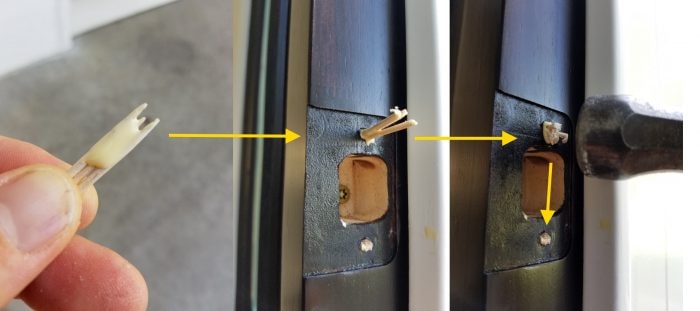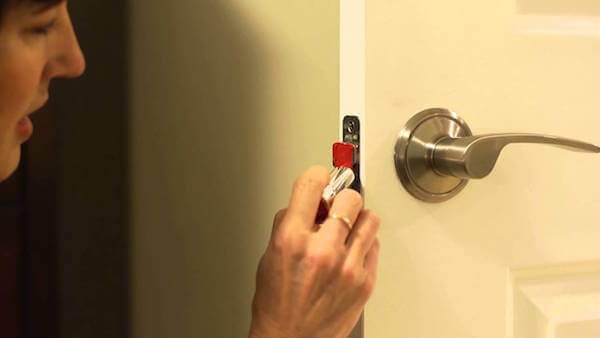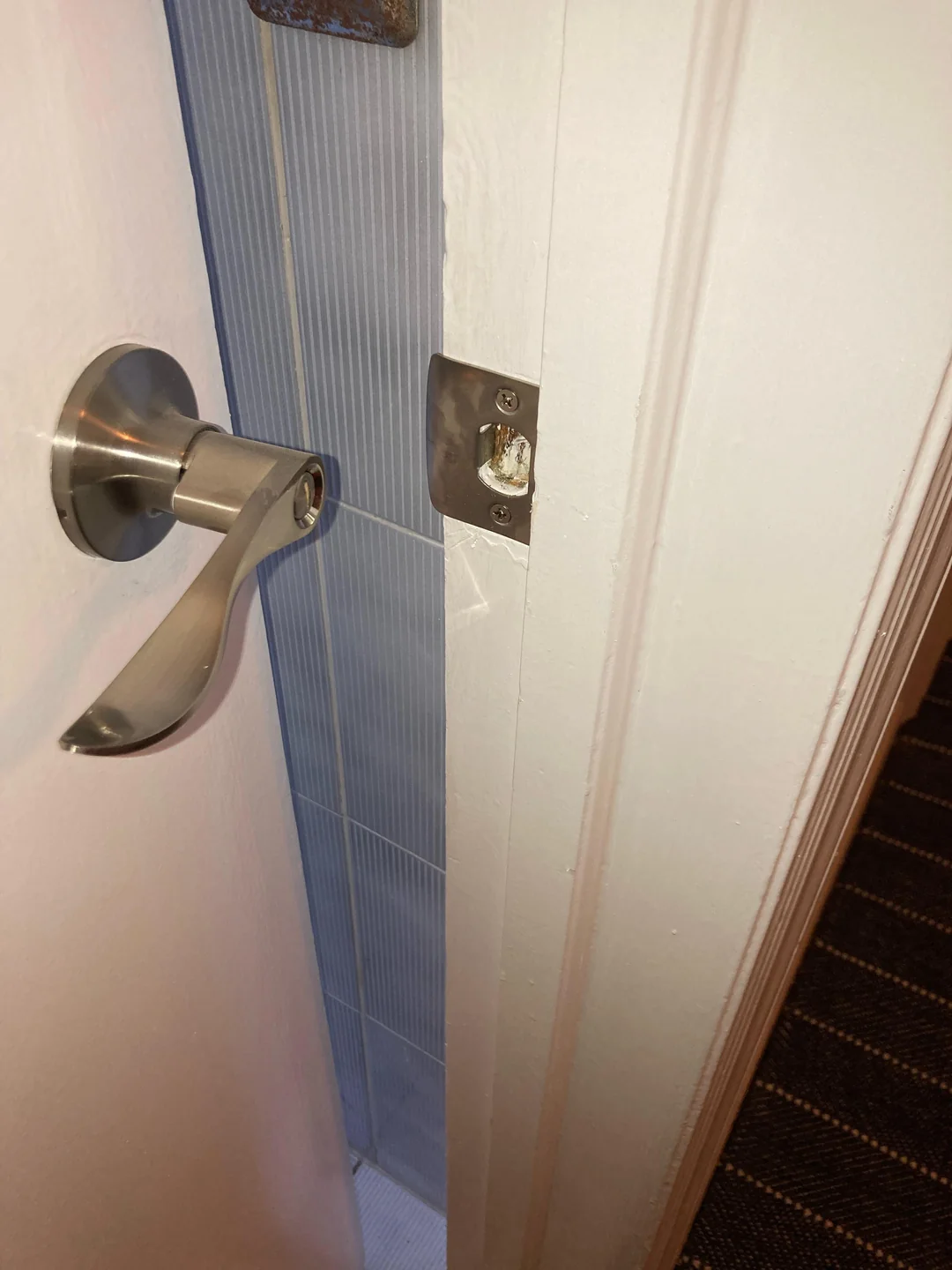My shopping cart
Your cart is currently empty.
Continue ShoppingHave you ever experienced a door that just won't close properly? It can be frustrating and inconvenient, especially if it's a frequently used entrance to your home or office. The most common reason for this problem is due to a faulty latch mechanism. This can happen over time due to wear and tear, or from improper installation. But don't worry, there are simple steps you can take to fix this issue without having to call a professional.
In this article, we will walk you through the process of how to fix a door that won't latch. We'll cover different types of latches and their functions, as well as the tools and materials you will need for the job. From adjusting the strike plate to replacing the entire latch mechanism, we will provide you with easy-to-follow instructions and tips to get your door latching properly again. So let's get started and say goodbye to that frustrating door that just won't close!

A latch is the mechanism that keeps a door closed and secure. It consists of two main parts: the latch itself, which is the metal piece that extends from the door and catches onto the strike plate on the door frame, and the strike plate, which is attached to the door frame and receives the latch.
When you close a door, the latch should fit into the strike plate and keep it securely closed. There are different types of latches available, such as spring latches, deadbolts, and mortise latches. The type of latch your door has will determine what steps you need to take to fix it.

Here are some common solutions for a door that won't latch properly:
The first step in fixing a door that won't latch is to check the alignment of the strike plate. Over time, the strike plate can become loose or shift slightly, causing it to be misaligned with the latch. This can prevent the latch from fitting properly into the strike plate and cause the door to not close properly.
To fix this issue, you will need a screwdriver and some small wooden toothpicks. First, remove the screws from the strike plate and insert a toothpick into each screw hole. The toothpicks will act as filler material and help tighten up any gaps between the strike plate and frame. Then, reattach the strike plate using the same screws and tighten them securely.
When it comes to fixing a door that won't latch, sometimes the solution can be as simple as removing any debris or obstructions that may be preventing the latch from functioning properly. This is especially true for doors that are frequently used and may have accumulated dirt or small objects in the latch mechanism over time.
To check for debris or obstructions, you will need a flashlight and a thin, pointed tool such as tweezers or a toothpick. Use the flashlight to inspect the latch and strike plate for any buildup of dirt or objects that may be blocking the latch from fully extending into the strike plate. If you find any, carefully remove them using your tool of choice and then try closing the door again to see if it latches properly.
Another common issue that can cause a door to not latch is loose screws on either the latch or strike plate. Over time, these screws can become loose and prevent the latch from fitting into the strike plate properly.
To fix this problem, use a screwdriver to tighten any loose screws on both the latch and strike plate. This should help realign them and ensure that they are securely attached to the door and frame.
If you notice that your door is having trouble latching even after adjusting the strike plate, checking for debris, and tightening loose screws, then you may need to lubricate the latch mechanism. Over time, the latch can become dry and stiff, making it difficult for it to move smoothly into the strike plate.
To lubricate the latch, you will need a silicone-based spray lubricant. Simply spray a small amount onto the latch and then try closing the door again. This should help loosen up any stiffness in the mechanism and allow it to function properly again.
In some cases, a door that won't latch may be caused by an issue with the door's alignment on its hinges. If this is the case, adjusting the hinges can help fix this problem.
First, check if there is any visible gap between the door and frame when it is closed. If there is, then you may need to adjust the hinges to bring the door closer to the frame. You will need a screwdriver and potentially some shims (small pieces of wood) for this solution.
Loosen the screws on one of the hinges, insert one or more shims between the hinge and frame, and then tighten the screws back up. This should help realign the door with the strike plate and allow it to latch properly.
If adjusting the hinges does not work, then you may need to replace them altogether. Over time, hinges can become worn out or damaged, causing issues with latching. To replace the hinges, you will need new hinges that are the same size and shape as your existing ones, as well as a screwdriver.
First, remove the old hinges from the door and frame using the screwdriver. Then, attach the new hinges in their place using screws. Make sure to tighten them securely to ensure proper alignment with the strike plate.
If you have tried all of the above solutions and your door still won't latch properly, then it may be time to replace the strike plate altogether. Over time, strike plates can become damaged or worn out, preventing them from functioning properly with the latch.
To replace a strike plate, you will need a chisel, hammer, and new strike plate that is the same shape and size as your existing one. First, use the chisel to remove any wood or debris around the current strike plate. Then, use the hammer to gently tap the new strike plate into place. Make sure it is aligned properly with the latch and screw it in securely using a screwdriver.
If you are not comfortable or confident in your ability to fix a door that won't latch, then it is always best to call a professional for assistance. They will have the necessary expertise and tools to diagnose and fix any issues with your door's latching mechanism effectively and efficiently. It may cost more initially, but can save you time and frustration in the long run.

A misaligned door latch can cause frustration and inconvenience as it prevents the door from closing properly. There are several signs that can indicate a misaligned door latch, such as difficulty in closing or opening the door, scraping or sticking sounds when trying to close the door, visible gaps between the door and frame when closed, or the latch not lining up with the strike plate.
If you notice any of these issues, it is likely that your door latch is misaligned and needs to be adjusted or replaced. Regularly checking for these signs can help prevent more significant problems in the future. So, it is essential to address them promptly by following the steps mentioned above.

There are several types of door latches, each with its unique mechanism and purpose. The most common ones include:
Spring latch- A spring latch is a common type of latch that uses a spring-loaded bolt to secure the door. The bolt retracts when the handle or knob is turned and automatically returns to its locked position when released. These latches are often used in interior doors where minimal security is required and are known for their simplicity and ease of use.
Deadbolt latch- Deadbolt latches provide enhanced security compared to spring latches. They use a solid steel bolt that is manually operated by a key or thumb turn. Unlike spring latches, deadbolts do not retract automatically, making them more resistant to forced entry. They are commonly used for exterior doors to provide robust locking mechanisms.
Mortise latch- A mortise latch is installed within a pocket (or mortise) cut into the door's edge. These latches are durable and often used in commercial or older residential properties. They combine elements of a latch and a lock, offering seamless functionality and security. Mortise latches are ideal for doors requiring a sophisticated, traditional mechanism.
Rim latch- A rim latch is surface-mounted onto the door rather than being installed within it. These latches are often used on lightweight or interior doors for basic locking needs. Rim latches are simple and versatile, offering a quick solution to secure doors without heavy-duty mechanisms.
Night latch- Night latches are commonly used for additional nighttime security on exterior doors. They are designed to automatically engage when the door is closed but can also be deadlocked for enhanced security. Their automatic locking feature makes them highly convenient for homeowners.
Looking for high-quality, modern, and stylish doors for your home or business? Look no further than My City Doors! We offer a wide variety of door options, including swing doors, pocket doors, barn doors, and more. Our showroom in Staten Island is open 7 days a week for you to browse and get inspired. Plus, our knowledgeable staff is available to assist you in finding the perfect door for your space.
At My City Doors, we pride ourselves on providing top-notch customer service and reliable products. Our partnerships with trusted manufacturers ensure that we offer only the best quality doors at competitive prices. Additionally, our extensive catalog includes various styles such as contemporary, traditional, rustic, and more, to suit any design aesthetic.
But our commitment to excellence doesn't stop there. We also offer installation assistance and have resources available on our website for easy installation. Plus, with our generous warranty and return policy, you can shop with confidence knowing that we stand behind our products.
Choose My City Doors for all your door needs and experience the best in customer service, wall framing, quality, and style. Contact us today or visit our showroom to see the difference for yourself!
A strike plate hole is where the door latch fits into the door frame. If it’s misaligned or damaged, you may need to adjust it using a dremel carbide cutter or wood filler to ensure the latch contacts properly.
To fix old screw holes in a door jamb, use wood filler to fill the holes, then drill new holes for the hinge screws or strike plate. Make sure the new screw holes are aligned with the door’s hinge mortise and strike plate mortise.
Aligning the latch hole with the strike plate requires adjusting the strike plate mortise on the door frame. Use a dremel carbide cutter to carefully reshape the mortise if needed, ensuring the latch contacts the strike plate properly.
To install or replace a door handle and latch, first make sure the latch hole aligns with the strike plate. If necessary, adjust the door jamb, and then secure the door handle by screwing it into the pre-drilled holes.
The top hinge helps support the door’s weight and ensures smooth swinging, while the bottom hinge keeps the door stable. Both hinges are installed into hinge mortises on the door and door frame using hinge screws.
A door that won't latch can cause inconvenience and even compromise security. By following these steps and tips, you can easily adjust or replace your door latch and ensure that it is functioning properly. Regular maintenance and checks can also help prevent larger issues in the future. Remember to use a suitable lubricant and consult a professional if you encounter any difficulties.
And for all your door needs, choose My City Doors - the trusted provider of high-quality, stylish doors. So why wait? Contact us today and upgrade your doors to enhance the security and aesthetic of your space!